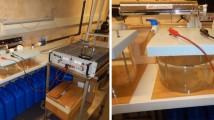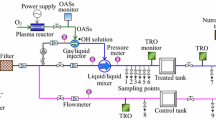Abstract
Ohmic heating and pulse low electric field (PLEF) treatments were applied to cause a lethal effect onAlexandrium catenella cells suspended in seawater. The survival ofA. catenella treated with ohmic heating decreased with electric field strength and treatment time. The maximum of only 10% reduction in survival was achieved with 1 s treatment at 50 V cm−1. On the other hand, the application of pulse low electric treatment of 70 V cm−1 field strength for 3 × 10 ms resulted in high destruction levels of A. catenella cells (survival 0.01%), thus is an effective method for inactivation of toxic dinoflagellates in ballast water.
Similar content being viewed by others

References
Anderson D.M. (1997). Turning back the harmful red tide. Nature, 388: 513.
Bolch C.J., Hallegraeff G.M. (1993). Chemical and physical options to kill toxic dinoflagellate cysts in ships’ ballast water. J. Mar. Environm. Eng., 1: 23–29.
Cangelosi A. (1997). The Algonorth experiment. Seaway Review, 25 (3): 29–33.
Chase C., Reilly C., Pederson J. (2001). Marine Bioinvasions Fact Sheet: Ballast water Treatment option. Cambridge MA: MIT Sea Grant Center for Coastal Resources.
Damar S., Bozoglu F., Hizal M., Bayindirih A. (2002). Inactivation and injury ofEscherichia coli O157:H7 andStaphylococcus aureus by pulsed electric fields. World J. Microbiol. Biotechnol., 18: 1–6.
Donsi G., Ferrari G., Pataro G. (2007). Inactivation kinetics ofSaccharomyces cerevisiae by pulsed electric fields in a batch treatment chamber: the effect of electric field unevenness and initial cell concentration. J. Food Eng., 78: 784–792.
Guillard R.R.L. (1975). Culture of phytoplankton for feeding marine invertebrates. In: Smith W.L., Chanley M.H., Eds., Culture of Marine Invertebrate Animals. Plenum Press, New York, pp. 26–60.
Guillou S., Murr N. E. (2002). Inactivation ofSaccharomyces cerevisiae in solution by low-amperage electric treatment. J. Appl. Microbiol., 92 (5):860–865.
Hallegraeff G.M., Bolch C.J. (1992). Transport of dinoflagellate cysts in ship’s ballast water: Implications for plankton biogeography and aquaculture. J. Plankton Res., 14: 1067–1084.
Hallegraeff G.M., Valentine J.P., Marshall J.M., Bolch C.J. (1997). Temperature tolerances of toxic dinoflagellate cysts: application to the treatment of ships’ ballast water. Aquat. Ecol., 31: 47–52.
Ichikawa S., Wakao Y., Fukuyo Y. (1992). Extermination efficacy of hydrogen peroxide against cysts of red tide and toxic dinoflagellates, and its adaptability to ballast water of cargo ships. Nippon Suisan Gakkaishi, 58: 2229–2233.
Kunihiko U., Seiichiro I. (2002). Developing a new apparatus for inactivatingEscherichia coli in saline water with high electric field AC. J. Food Eng., 53 (3): 203–207.
Montani S., Meksumpun S., Ichimi K. (1995). Chemical and physical treatments for destruction of phytoflagellate cysts. J. Mar. Biotechnol., 2: 179–181.
Mossel D.A.A., Corry J.E.L., Struijk C.B., Baird R.M. (1995). Essentials of the Microbiology of Foods: A Textbook for Advanced Studies. Wiley, Chichester, UK.
Park J.C., Lee M.S., Han D.W., Lee D.H., Park B.J., Lee I.S., Uzawa M., Aihara M., Takatori K. (2004). Inactivation ofVibrio parahaemolyticus in effluent seawater by alternating-current treatment. Appl. Env. Microbiol., 7 (3): 1833–1835.
Rigby G.R., Hallegraeff G.M. (1994). The transfer and control of harmful marine organisms in shipping ballast water: Behaviour of marine plankton and ballast water exchange trials on the MV “Iron Whyalla”. J. Mar. Environm. Eng., 1: 91–110.
Rigby G.R., Taylor A.H. (2001). Ballast water treatment to minimize the risks of introduction nonindigenous marine organisms into Australian ports. Review of current technologies and comparative costs of practical options. AFFA Ballast Water Series, Report 13.
Taylor A., Rigby G., Gollasch S., Voigt M., Hallegraeff G.M., McCollin T., Jelmert A. (2002). Preventive treatment and control techniques for ballast water. In: Leppakoski E., Olenin S., Gollasch S., Eds, Invasive Aquatic Species in Europe: Distributions, Impacts and Management. Kluwer Scientific Publishers, Dordrecht, pp. 484–507.
Yoshida M., Fukuyo Y., Murase T., Ikegama T. (1996). Onboard observations of phytoplankton viability in ship’s ballast tanks under critical light and temperature conditions. In: Yasumoto T., Oshima Y., Fukuyo Y., Eds, Harmful and Toxic Algal Blooms. IOC. Paris, pp. 205–208.
Zhang Q.H., Monsalve-Gonzalez A., Barbosa-Cánovas G.V. Swanson B.G. (1994a). Inactivation ofE. coli andS. cerevisiae by pulsed electric fields under controlled temperature conditions. Transactions of the ASAE, 37: 581–587.
Zhang Q.H., Monsalve-Gonzalez A., Barbosa-Cánovas G.V., Swanson B.G. (1994b). Inactivation ofS. cerevisiae in apple juice by square-wave and exponential-decay pulsed electric fields. J. Food Eng., 17: 469–478.
Author information
Authors and Affiliations
Corresponding author
Rights and permissions
About this article
Cite this article
Satirapipathkul, C., Iwakabe, K., Habaki, H. et al. Inactivation of harmful dinoflagellate (Alexandrium catenella) in ballast water by electric treatment. Ann. Microbiol. 58, 297–301 (2008). https://doi.org/10.1007/BF03175333
Received:
Accepted:
Issue Date:
DOI: https://doi.org/10.1007/BF03175333



